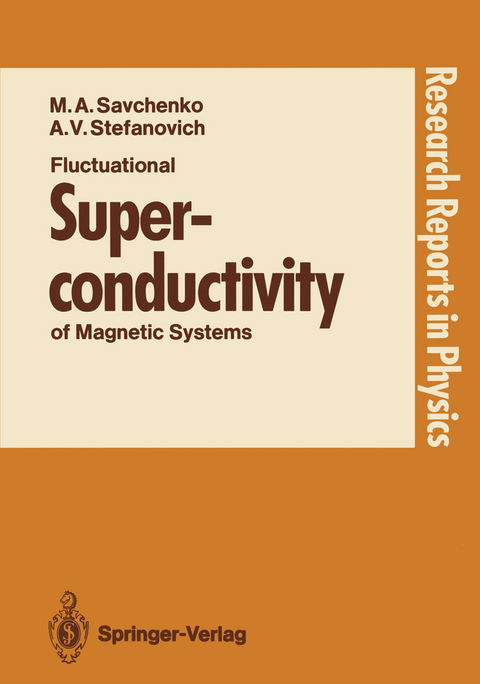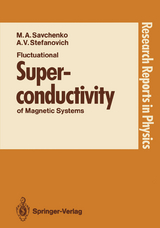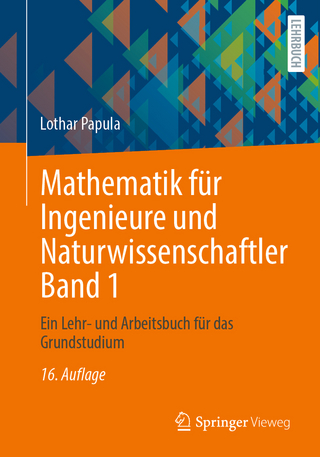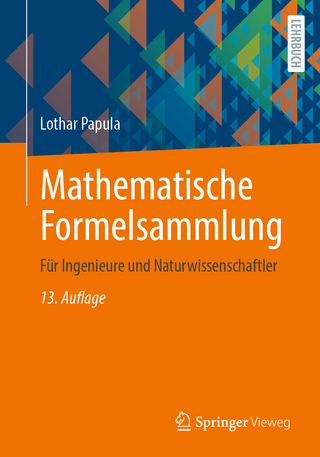Fluctuational Superconductivity of Magnetic Systems
Springer Berlin (Verlag)
978-3-540-50561-7 (ISBN)
1. Introduction.- 2. Exchange Enhancement Effect During Phase Transitions in Magnetically Ordered Crystals.- 2.1 Phase Transition in a Ferromagnet with Quadrupole Interaction.- 2.2 Phase Transition in an Antiferromagnet in a Strong Magnetic Field.- 2.3 Fluctuations and Spin Waves in Ferroelectro-antiferromagnets in a Strong Magnetic Field.- 2.4 Phase Transition in a Crystal with Dislocations in a Strong Magnetic Field.- 3. Phase Lamination and the Exchange Enhancement Effect.- 3.1 Phase Transitions in Complex Magnetic Structures and the Exchange Enhancement Effect in Spin-Orbit Interaction.- 3.2 Phase Diagrams of Complex Magnetic Structures: Phase Lamination.- 3.3 Phase Transitions in Ferroelectro-antiferromagnets.- 4. Superconducting Phases in Rare-Earth Metal Compounds: Phenomenological Theory.- 4.1 Superconducting Compounds of Rare-Earth Metals: Formulation of the Problem.- 4.2 Fluctuation Free Energy: Renormalization Group Equations.- 4.3 Phase Diagram of the Superconducting Compounds of Rare-Earth Metals.- 4.4 Topological Analysis of the Phase Diagram of Superconducting Compounds of Rare-Earth Metals.- 5. Theory of High-Temperature Superconducting Phases in Rare-Earth Metal Compounds.- 5.1 Lagrangian of the System near the Point of Phase Transition to Superconducting State.- 5.2 Electron-Phonon Interaction Parameter for the High-Temperature Superconducting Phase.- 6. Solitons in the Theory of Superconductivity of Magnetic Systems.- 6.1 Generalized Order Parameter in Magnetic Superconductors: Equations for the Superconducting Phase.- 6.2 Soliton Mechanism for Emergence of Superconductivity Accompanying a Phase Transition from Superconducting to Paramagnetic States.- 6.3 Solitons in an Inhomogeneous Superconducting State and Topology.- 6.4 Solitons in the Phase of Coexistence of Superconductivity and Magnetism.- 7. Spin Glasses Based on Rare-Earth Metal Compounds.- 7.1 Phase Transitions in Heavy Rare-Earth Metals.- 7.2 Modern Spin Glass Models.- 7.3 Peculiarities of Vector Fields in Heavy Rare-Earth Metals.- 7.4 Magnetic Susceptibility in the New Spin Glasses.- 7.5 Superconducting Phases in Spin Glasses.- 7.6 Peculiarities of Spin-Wave Dynamics in Spin Glasses.- 8. High-Temperature Superconducting Ceramics.- 8.1 High-Temperature Superconducting Oxides.- 8.2 Spectrum of Quasi-Particles Exchanged by Electrons in HTS Ceramics.- 8.3 Possibility of Increasing the Critical Temperature: Properties of High-Temperature Superconductors.- 9. Theory of High-Temperature Superconductivity of Ceramic Systems.- 9.1 Microscopic Equations for the Superconducting Phase.- 9.2 Separation of Many-Particle Averages in the Superconducting Phase Equations: Wick’s Theorem.- 9.3 Electron-Phonon Interaction in Superconducting Phases: Superconducting Transition Temperature.- 9.4 Phase Lamination in Superconducting States.- 9.5 Microscopic Equations near the Phase Transition Point: Relation to the Phenomenological Theory.- 10. Theory of High-Temperature Superconductivity of Polymer Systems.- 10.1 Quasi-One-Dimensional Organic Superconductors: Polyacetylene as a Possible Superconductor.- 10.2 Criterion for the Emergence of Superconductivity in Polyacetylene.- 10.3 High-Frequency Properties of Polyacetylene in the Nonsuperconducting State.- References.
| Erscheint lt. Verlag | 17.5.1990 |
|---|---|
| Reihe/Serie | Research Reports in Physics |
| Übersetzer | Ram S. Wadhwa, Natalie Wadhwa |
| Zusatzinfo | IX, 258 p. 1 illus. |
| Verlagsort | Berlin |
| Sprache | englisch |
| Maße | 170 x 242 mm |
| Gewicht | 456 g |
| Themenwelt | Mathematik / Informatik ► Mathematik ► Angewandte Mathematik |
| Naturwissenschaften ► Chemie ► Physikalische Chemie | |
| Naturwissenschaften ► Physik / Astronomie ► Elektrodynamik | |
| Naturwissenschaften ► Physik / Astronomie ► Festkörperphysik | |
| Technik ► Elektrotechnik / Energietechnik | |
| Technik ► Maschinenbau | |
| Schlagworte | Hochtemperaturleitung • Magnetische Eigenschaften • Phrasenübergänge • Physikalische Chemie • Supraleitung |
| ISBN-10 | 3-540-50561-X / 354050561X |
| ISBN-13 | 978-3-540-50561-7 / 9783540505617 |
| Zustand | Neuware |
| Informationen gemäß Produktsicherheitsverordnung (GPSR) | |
| Haben Sie eine Frage zum Produkt? |
aus dem Bereich




